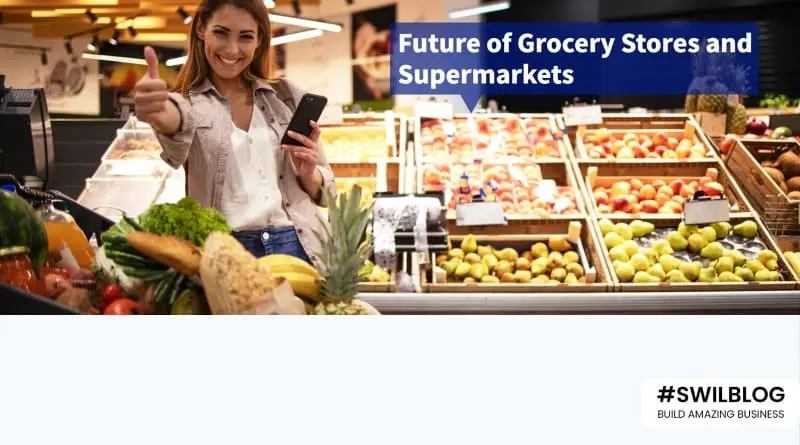The market for food technology has grown significantly recently and will continue to grow. Industry pioneers have started venture funds and initiatives to inject even more funding into the market.
To capitalize on the prevailing trends, grocery stores and supermarkets have established partnerships with e-commerce sites and CPG (consumer packaged goods) firms.
Grocery Trend influencing the stores and supermarkets
Article Content–
The 6 grocery trends most likely influencing the industry moving forward are listed below.
- Customer Experience with Omnichannel Grocery Stores
- Every Turn is Automated
- Better Convenience
- Customized Online Experiences
- Improved Use of Customer Data
- Recruiting tech talent
- Conclusion
1. Customer Experience with Omnichannel Grocery Stores
Retail grocery is a part of omnichannel retail. Most consumers, according to research, do their product research online before going shopping. To keep up with technological changes in the food market, retailers must grasp omnichannel commerce.
Grocery stores should permit premium content on their e-commerce pages so that their suppliers may provide consumers with informative message and media that increases conversions. Grocery merchants made up seven of the top 16 firms offering exceptional omnichannel customer service.
The survey claims that grocery stores and general merchandise merchants provide services like the opportunity to contact order pickers, flexible delivery and pickup options, expedited delivery, and real-time order tracking, offering the most sophisticated ordering and fulfillment capabilities.
Grocery stores are the most omnichannel in both adoption and services. Customers can switch between in-person and online shopping at retail box stores. It promotes a cohesive product content experience wherever the customer interacts with the retail brand by enabling them to conduct research in-store from their devices via omnichannel applications.
2. Every Turn is Automated
Every aspect of the retail grocery industry is being affected by automation, which is sweeping the sector. In supermarket warehouses, robot automation is most prevalent. When a company constructed automated warehouses around the nation in 2021, it garnered widespread media attention.
The grocery company performed a precise choreography across each facility as it deployed robots to fetch colored shopping totes. However, automation in the retail grocery industry plays more roles than warehouse technology.
On the front lines and in client contacts, we observe greater automation. In the retail grocery sector, self-checkout kiosks and product-scanning robots reduce the workload on employees and boost operational effectiveness. Automation is expected to balance the workforce deficit and related costs.
3. Better Convenience
The preference for quick ways to fill up on groceries will probably increase. While pickup and drive-up are gaining popularity, online shopping is unquestionably a fantastic alternative.
The recent advent of drive-through grocery stores has altered how consumers view convenience. Customers can place their order online, choose pickup, and then drive to the store to pick it up. Two alternatives are a kiosk or an employee who loads the charge into the car.
4. Customized Online Experiences
Scalable personalization can boost food retailers’ overall sales by one to two percentage points. When multiplied by millions of shoppers, that is a considerable amount. Customer loyalty is increased, and personalized experiences increase sales, but these programs also reduce marketing and sales costs by up to 20% in some circumstances.
Customers feel connected when they obtain pertinent recommendations that seem custom-made for their particular needs. Customers, both individual and business, want to feel like more than just a name or a number.
They have a wide range of retail grocery options, but they want to spend their money with a business that goes above and beyond to give them a unique online experience.
Customers are likelier to stick with a retailer and follow the personalized recommendations they receive when shops provide them insights based on products they already use and appreciate.
5. Improved Use of Customer Data
These digital interactions are essential for marketing, customer retention, and sales efforts because they allow merchants and distributors to gather consumer data from online grocery purchases. Even when purchasing their milk and eggs, consumers demand personalized experiences, as was previously mentioned.
Retailers can better understand and please their customers using data from digital interactions. As stores struggle with low stock and out-of-stock problems, this trend will become even more critical for keeping customers.
Grocers can leverage consumer data to propose potential replacements based on a customer’s past purchases and browsing activities instead of merely announcing that an item is no longer available. Retailers can foresee consumer wants and carry the product that their customers want thanks to purchase data.
Depending on the retailer, online shoppers buying behaviors differ from in-store customers. Retailers may better meet the specific demands of their online audience by gathering and analyzing data from online consumers, which will boost customer happiness and retention.
6. Recruiting tech talent
Only recently, the retail grocery sector and the tech market overlapped. Food retail involves more than just logistics. The industry has become digital, and distributors and retailers must find staff that reflects this. Digital skills will fuel the success of retail grocery distributors and merchants.
Even individuals not in leadership positions, such as frontline workers, are expected to rise in value. The “AAA skill set,” or analytics, automation, and artificial intelligence, was revealed to be the most in-demand digital skill set in the grocery business.
Retail groceries are going digital, so brands and companies need to hire many people who can lead the sector toward a tech-driven future.
Conclusion
The retail grocery market has undergone more significant changes recently than ever before. Technology advances affect the market and have changed how consumers and retailers buy groceries.
To succeed in your industry, sellers, distributors, and retailers must keep up with current developments. The materials and toolkit for data management provided by Swil can be helpful. To start the conversation right now, get in touch with our staff.








